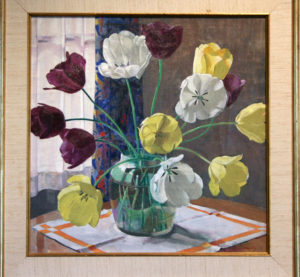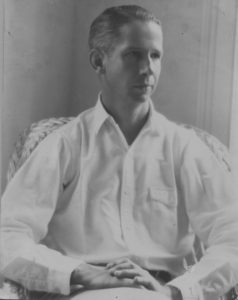
Color and share this work from our permanent collection!
Carl Lawless enjoyed using flowers from his own garden in Mystic as the subjects for his still lifes.
How will you color this work?
CLICK HERE TO DOWNLOAD COLORING PAGE!
Tag your unique takes using #ColoringWithMMoA to be featured!
Instagram: @MysticMuseumofArt
Facebook: /MysticMuseumofArt
Don’t use social media, but want to be featured in the ‘Coloring with MMoA’ page gallery on our website? Email your submission to the Visitor Services Manager (cara@mysticmuseumofart.org)
Carl Lawless (1894-1964), Bouquet of Tulips, undated. Oil. MMoA Permanent Collection. Donated by James H. Allyn.
Carl Lawless: 1894-1964

Carl Lawless, a native of Illinois, became one of the shining lights of the Mystic Art Association. He studied at the Chicago Academy of Fine Arts and the Pennsylvania Academy of the Fine Arts. He was one of a group of promising art students who won Cresson traveling scholarships at the Pennsylvania Academy during the years of World War 1, and who all went together to study and travel in Europe in 1921 after the war.
He made the acquaintance of fellow students and traveling scholarship winners Gladys Edgerly and Kenneth Bates. Gladys and Ken were married in 1923 and the following year purchased a 1729 house in Mystic to which they invited their friends from student days to come for visits. Carl Lawless was one of those who came. He liked Mystic so much that he purchased property off Orchard Lane in 1925 where he established his studio and year round residence. He had been living and painting in Stony Run, Pennsylvania, after his return from European studies. Lawless immediately became active in the growing art association and developed his own distinct style of landscape and still life painting, profiting from the friendship and ideas on art of Charles H Davis.
Lawless had already begun to exhibit his work before moving to Mystic and had won prizes at both the Pennsylvania Academy show in 1922 and the National Academy of Design exhibit in New York in 1923. Numerous other awards were to follow as he continued his art career. He became a member of the New Haven Paint and Clay Club, the Connecticut Academy of Fine Arts and, of course, the Mystic Art Association. He was represented at the prestigious, non-profit Grand Central Art Galleries in New York.
He was a popular and very helpful member of the Mystic Art Association. He was elected treasurer of the Association in 1930, was a member of the exhibition committee for the opening exhibit of the new gallery building in 1931, and exhibited in the show.
Carl Lawless headed up the gang of landscapers who were charged with bringing order and beauty to the gallery grounds, which had been roughed up by the recent construction. He engineered the digging up and removal of an entire side lawn from the Bate’s residence and its relocation at the gallery; transplanted cedars from the grounds of Professor Percy Boynton; and replanted summer flowers from the garden of Dr. George Leonard and from his own garden at Orchard Lane. Everything was done in time for the grand opening of the gallery on July 24, 1931!
Lawless saw patterns in nature and developed a style of painting that brilliantly incorporated these patterns into an overall design that was authentic to nature yet very much his own. Any season of the year was transformed on his canvases into a compelling and appealing work of art by the magic of his gifts. Cool, crisp snowscapes, autumn scenes that were colorful but not sentimental, bright summer landscapes-barns, houses, rivers, clouds, and sky, hills and trees-all and more became part of the Lawless vision of art, nature, and beauty.
Flowers from his own gardens were favorite motifs in his still lifes, often with a figurine or some small dish or other object to add to the composition, and perhaps a tapestry on the background wall. Typical was the use of a square canvas, with gold frames and wide silk liners from the Newcomb-Macklin frame company in Chicago.
His work is in the collections of the Pennsylvania Academy of Fine Arts; the Carlisle (PA) Museum; the New Haven Public Library; the University of Connecticut; and the Mystic Art Association. Lawless achieved, through his generous activities and his fine, thoughtful, and skillful work, an indelible place of distinction in the Mystic Art Association and in American art.
Previously published in the Mystic Art Center’s (presently known as Mystic Museum of Art) News & Views September 1998 by Priscilla W. Pratt and Lois H. Constantine of the Historical Committee.

